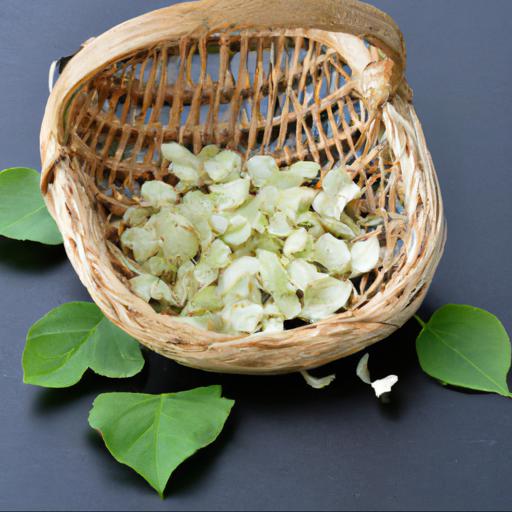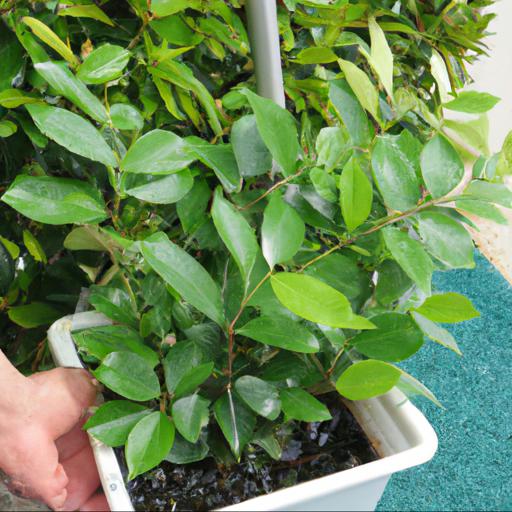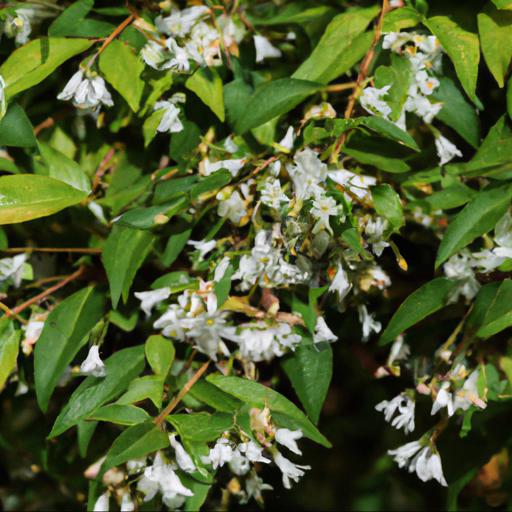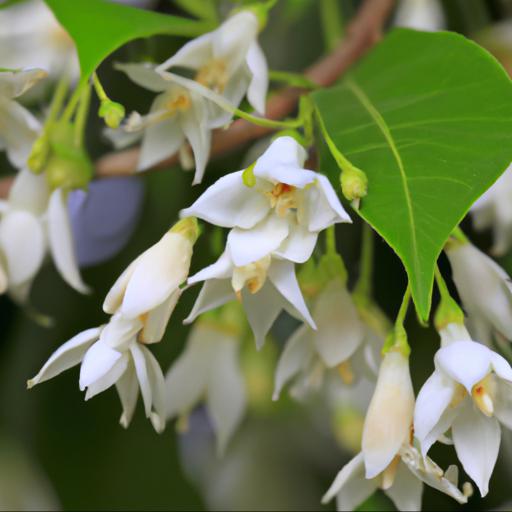Styrax japonicus, also known as Japanese Snowbell, is an ornamental tree native to Japan. It is a deciduous tree with attractive, bell-shaped white flowers that bloom in the spring. The leaves are glossy green and the bark is smooth and gray.
The tree has a graceful form and is often used in landscaping as a specimen tree or in a shrub border. Styrax japonicus is easy to grow and maintain, making it a popular choice for home gardeners.
It can tolerate a wide range of soil conditions and is tolerant of drought and heat. With its beautiful blooms and lush foliage, Styrax japonicus is a stunning addition to any garden.
Benefits of styrax japonicus

For gardeners looking for a shimmer of texture, elegance and subtle colour in their garden, Styrax japonicus is the perfect addition. This beautiful deciduous shrub is native to Asian woodlands and brings a delicate yet eye-catching charm to any garden.
Aptly described as ‘lacy snow’ due to its distinct foliage, Styrax japonicus can reach heights of up to 5 metres and sprouts fragrant, bell-shaped, white-green flowers in early July. The growth habit of this majestic shrub is bushy yet upright, making it a great backdrop for perennials and small trees alike. Perfect for adding a splash of softness to your budding cultivated landscape, it also provides a great habitat for birds thanks to its large, translucent leaves.
In addition, Styrax japonicus is incredibly hardy and tolerates a wide range of conditions. As long as you suit its preferences for effectively drained soils and partial shade, this majestic shrub will deliver season after season of vibrant foliage and captivating flowers. It will even survive temperatures down to -15 °C!
Furthermore, the foliage is incredibly long lasting, persisting well into early winter, giving your garden an alluring seasonal presence. Whether you’re in the garden to relax or to revitalize, Styrax japonicus will be sure to add a touch of class and finesse.
Growing and caring for styrax japonicus

Styrax japonicus, or Japanese snowbell, is an elegant evergreen shrub that has stunning white, bell-shaped flowers which delicately dangle from its branches in spring and summer. Growing to around four metres high in the UK, this stunning specimen is relatively easy to care for, making it a great choice for any garden. Cultivation of Styrax japonicus is very straightforward for those with a bit of gardening knowledge, or a willingness to learn.
Like most plants, it should be planted in well-draining soil in a sunny or partially shaded spot, which should be kept moist but not overly wet. Water can be reduced in the winter months when the plant becomes dormant, and a soil-based fertiliser can be used in early spring to keep this beauty in top condition.
And of course, it’s always essential to keep an eye out for any pests or diseases that may be attacking the Styrax japonicus if you’re looking to keep it looking its best. A regular trim in the early spring can help to keep the shrub in shape and ensure it won’t grow too tall for its surroundings.
Even during the winter months, it’s best to keep on top of any dead or broken branches to protect the plant from any further damage. In short, Styrax japonicus requires minimal effort to maintain for those with a little bit of gardening expertise and dedication. A stunning addition to any garden, this shrub can add a beautiful and delicate touch whatever the season.
Styrax japonicus in landscaping

Styrax japonicus is an excellent tropical shrub for landscaping. It’s ideal for adding a subtle, oriental touch to any garden, impressing onlookers with its unique beauty.
Also known as the Japanese Snowbell tree, Styrax japonicus is an evergreen, broadleaf beauty. It can be pruned into a single-trunked tree, or else left in its natural, multi-branched form. If you’re looking to add some statement vibes to your garden, Styrax japonicus is the perfect choice.
It can reach up to 6 or 8 meters tall, with a spread of around 4 meters. Its beautiful bell-shaped white flowers appear from April to May, and last for several weeks, continuing to make your garden look breathtakingly beautiful.
The nicest thing about Styrax is that it’s not a high-maintenance shrub. The tree prefers slightly acidic to neutral soil and full sun, but should be protected to some degree from drying winds. Pruning is a breeze – but you can also let the natural style of the tree take its course, if you prefer.
Whatever you decide, the tropical chic of Styrax japonicus will impress passers-by – and provide you with a refreshing little corner of nature close to home.
Styrax japonicus in traditional medicine
Styrax japonicus is a species of flowering tree native to Japan, Korea, and Manchuria. The tree is also known as Japanese snowbell, Japanese wax tree, or Japanese pagoda tree, due to its bell-shaped white flowers that hang in clusters from the tree in spring and summer.
In the traditional medicine of the East, Styrax japonicus has been used for centuries for a wide variety of health problems, from chronic swelling and digestive issues to pain relief. The active components of Styrax japonicus contain several beneficial metabolites, including resins, saponins, and phenolic compounds, which consist of the flavonoids and proanthocyanidins. These compounds are thought to have a number of pharmacological properties, such as anti-inflammatory, anti-oxidant, antifungal, and antimicrobial activity.
The tree’s bark and roots have also been used in traditional medicine to treat a range of conditions, including fever, headache, menstrual pains, inflammation of the joints, and cough. In this day and age, Styrax japonicus is cultivated around the globe as an ornamental tree, and its beauty is celebrated in many parks and gardens worldwide. In traditional medicinal practices, the leaves and bark of theStyrax japonicus tree can be used in topical applications or in teas to treat various ailments.
The bark can also be powdered, mixed with water to form a paste, and applied to wounds or ulcers as an anti-inflammatory or minor pain reliever. Whether you’re a home gardener or a traditional medical practitioner, Styrax japonicus is knowledgeable source of natural herbal remedies.
Conclusion
Styrax japonicus, also known as Japanese Snowbell, is a flowering tree native to Japan. It produces white bell-shaped flowers in late spring, followed by small, round fruits in the fall.
The leaves are oval and glossy, and the bark is smooth and gray. Styrax japonicus is popularly used in landscaping, with its attractive flowers and fruits providing visual interest throughout the year. It is also a great choice for naturalizing in woodlands and along stream banks.
FAQ
What is the scientific name of the Japanese snowbell tree?
The scientific name of the Japanese snowbell tree is Styrax japonicus.
Where is the Japanese snowbell tree native to?
The Japanese snowbell tree (Styrax japonicus) is native to Japan, Korea, and parts of China.
What are the characteristics of the Japanese snowbell tree?
The Japanese snowbell tree (Styrax japonicus) is an ornamental tree that is known for its fragrant white flowers and glossy green foliage. It is a small to medium-sized tree, typically growing to 10-20 feet tall, with a rounded canopy. It has smooth, gray bark and its leaves are oval-shaped, with serrated edges. The flowers are bell-shaped, white, and fragrant, and bloom in late spring to early summer. The tree is tolerant of a wide range of soil types and prefers full sun to partial shade.
How tall does the Japanese snowbell tree typically grow?
The Japanese snowbell tree typically grows to a height of 15-25 feet.
What type of soil does the Japanese snowbell tree prefer?
The Japanese snowbell tree prefers moist, well-drained, acidic soil.
What type of climate is best suited for the Japanese snowbell tree?
The Japanese snowbell tree is best suited for a temperate climate with mild winters and warm summers.

